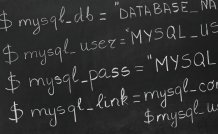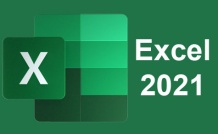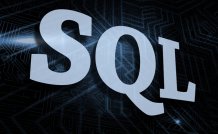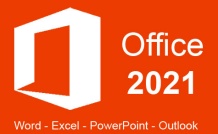Online Class: Introduction to SQL
This comprehensive course teaches and demonstrates all aspects of SQL. While you'll learn everything there is to do with SQL, this course assumes you have no prior SQL experience and is for the complete beginner.

$70.00
no certificate
no certificate
- OR -
$95.00
with CEU Certificate*
with CEU Certificate*
Start Right Now!
$95.00 (with CEU Certificate)
Taking multiple courses? Save with our platinum program.
-
16Lessons
-
18Exams &
Assignments -
5,054Students
have taken this course -
17Hours
average time -
1.7CEUs
Course Description
This comprehensive course teaches and demonstrates all aspects of SQL. While you'll learn everything there is to do with SQL, this course assumes you have no prior SQL experience and is for the complete beginner.
Structured Query Language (SQL) is the language of databases. Whether you run reports or provide a dynamic website, you need to know SQL to add, delete, edit and view records. Databases organize and collect your data, and the SQL language is the liaison between you and the data. The role of database administrator includes several functions that you should know. You should know how to create and design tables, manipulate your data and run reports, create small programs (stored procedures) and use more advanced concepts such as transactional support and cursors.
Structured Query Language (SQL) is the language of databases. Whether you run reports or provide a dynamic website, you need to know SQL to add, delete, edit and view records. Databases organize and collect your data, and the SQL language is the liaison between you and the data. The role of database administrator includes several functions that you should know. You should know how to create and design tables, manipulate your data and run reports, create small programs (stored procedures) and use more advanced concepts such as transactional support and cursors.
This course provides a step-by-step overview and instructions that help you get started with the SQL language. We'll first get started with understanding data structures and techniques for all SQL engines including Access, Oracle and MySQL. We show you how to create SQL statements including SELECT, DELETE, UPDATE and INSERT. Then, we show you how to create and design tables. We show you how to create stored procedures, which allow you to run the same SQL statement multiple times without reprogramming your database. Finally, we show you how to use cursors, use transactions to preserve data integrity, and creating views for larger data sets.
Whether you're new to database administration or want to create customized, personal reports for your online business, this course shows you how to get started and helps you understand the SQL language from the ground up using very easy language, script examples, and HD Video demonstrations.
- Completely Online
- Self-Paced
- Printable Lessons
- Full HD Video

- 6 Months to Complete
- 24/7 Availability
- Start Anytime
- PC & Mac Compatible
- Android & iOS Friendly
- Accredited CEUs

Course Lessons
Lesson 1: Introduction to SQL
This class assumes that you know nothing about the SQL language and gives you an introduction to the way databases work and how you can manage your data. This first lesson therefore begins this introduction.
Additional lesson topics: Learning SQL; SQL Cookbook
10 Total Points
 Lesson 1 Video
Lesson 1 Video Lesson discussions: Reasons for Taking this Course
Lesson discussions: Reasons for Taking this Course Complete Assignment: Course Introduction and Goals
Complete Assignment: Course Introduction and Goals Assessment: Lesson 1 Exam
Assessment: Lesson 1 Exam
Lesson 2: Retrieving Data
Storing data is just one part of database functionality. You need to have the ability to retrieve your data, which you do using the SQL language.
Additional lesson topics: SQL Fundamentals; Retrieving Data with SQL Queries
10 Total Points
 Lesson 2 Video
Lesson 2 Video Assessment: Lesson 2 Exam
Assessment: Lesson 2 Exam
Lesson 3: Updating Data
After you know how to store your data, at some point you'll need to update or edit it. SQL uses the "UPDATE" statement to edit data in your tables.
Additional lesson topics: SQL UPDATE Statement; SQL
8 Total Points
 Lesson 3 Video
Lesson 3 Video Assessment: Lesson 3 Exam
Assessment: Lesson 3 Exam
Lesson 4: Inserting Data
INSERT adds new records to your tables. You can add static values, values from a stored procedure, or even values from another table.
Additional lesson topics: SQL: INSERT Statement; INSERT Examples Transact-SQL
9 Total Points
 Lesson 4 Video
Lesson 4 Video Assessment: Lesson 4 Exam
Assessment: Lesson 4 Exam
Lesson 5: Deleting Data
Deleting is a sensitive task, because you remove data from your tables. Deleting data can cause a number of issues, so it should be used with caution.
Additional lesson topics: Deleting Data from an SQL Table; Deleting Rows by Using DELETE
10 Total Points
 Lesson 5 Video
Lesson 5 Video Assessment: Lesson 5 Exam
Assessment: Lesson 5 Exam
Lesson 6: Sorting and Filtering Data
SQL uses the ORDER BY statement to sort records. You can sort records in ascending or descending order, and you can sort records based on multiple columns.
Additional lesson topics: 10 tips for sorting, grouping, and summarizing SQL data; How to do sorting on irregular Alphanumeric data in postgres sql
10 Total Points
 Lesson 6 Video
Lesson 6 Video Assessment: Lesson 6 Exam
Assessment: Lesson 6 Exam
Lesson 7: Advanced Filtering
SQL gets complex when you have multiple business rules that run how you return record sets. As a coder, you gather business rules that then decide how to structure your SQL statements to ensure that returned results are accurate for reports and applicatio
Additional lesson topics: Filtering and Selecting Data for Analyses; Filtering Rows by Using WHERE and HAVING; View Filter Information SQL Server Profiler
10 Total Points
 Lesson 7 Video
Lesson 7 Video Assessment: Lesson 7 Exam
Assessment: Lesson 7 Exam
Lesson 8: Summarizing Data
In most reporting requirements, you need to use aggregate functions. Aggregate functions are premade SQL functions that you can use instead of building your own code.
Additional lesson topics: Summarizing Data; Summarizing Data Results from a SQL Query
10 Total Points
 Lesson 8 Video
Lesson 8 Video Assessment: Lesson 8 Exam
Assessment: Lesson 8 Exam
Lesson 9: Grouping Data
The SQL language incorporates the GROUP BY operator to group data into sections or parts.
Additional lesson topics: Having Sums, Averages, and Other Grouped Data; Summarizing and Grouping Data in SQL
8 Total Points
 Lesson 9 Video
Lesson 9 Video Assessment: Lesson 9 Exam
Assessment: Lesson 9 Exam
Lesson 10: Using Subqueries
Subqueries let you return records from another table or database and use the subquery data set to then manipulate records in other parts of your database.
Additional lesson topics: Subquery Fundamentals; SQL Subquery Example; The Power of Subqueries
8 Total Points
 Lesson 10 Video
Lesson 10 Video Assessment: Lesson 10 Exam
Assessment: Lesson 10 Exam
Lesson 11: Joining Tables
With the JOIN statement, you can link one or several tables and consolidate SELECT queries into one returned data set.
Additional lesson topics: Join data from two tables using SQL; SQL Tutorial
9 Total Points
 Lesson 11 Video
Lesson 11 Video Assessment: Lesson 11 Exam
Assessment: Lesson 11 Exam
Lesson 12: Managing Tables
Design and management of your tables include creating, editing and deleting (dropping) tables.
Additional lesson topics: Guide to SQL Server data management and data quality; Managing Tables
9 Total Points
 Lesson 12 Video
Lesson 12 Video Assessment: Lesson 12 Exam
Assessment: Lesson 12 Exam
Lesson 13: Using Views
Views are preset data sets that you can use to query data you commonly query in your stored procedures or SQL statements.
Additional lesson topics: SQL: VIEWS; SQL VIEW Basics
10 Total Points
 Lesson 13 Video
Lesson 13 Video Assessment: Lesson 13 Exam
Assessment: Lesson 13 Exam
Lesson 14: Stored Procedures
Stored procedures are one or more SQL statements that perform some action on the database. The action can be anything from creating a table, deleting data or retrieving data from your tables.
Additional lesson topics: Create a Stored Procedure; SQL Server Stored Procedure tutorial and example
10 Total Points
 Lesson 14 Video
Lesson 14 Video Assessment: Lesson 14 Exam
Assessment: Lesson 14 Exam
Lesson 15: Using Cursors
Cursors let you create loops in your stored procedures, so you can evaluate data record-by-record.
Additional lesson topics: SQL Server Cursor Example; Cursors: An Overview
10 Total Points
 Lesson 15 Video
Lesson 15 Video Assessment: Lesson 15 Exam
Assessment: Lesson 15 Exam
Lesson 16: Using Transactions
Transactions are a solution for this phenomenon. Transaction statements let you roll back changes and avoid data integrity when one statement relies on a previous statement and the previous statement fails.
Additional lesson topics: SQL; Introduction to Transactions
83 Total Points
 Lesson 16 Video
Lesson 16 Video Lesson discussions: What is your opinion of this course?; Program Evaluation Follow-up Survey (End of Course); Course Comments
Lesson discussions: What is your opinion of this course?; Program Evaluation Follow-up Survey (End of Course); Course Comments Assessment: Lesson 16 Exam
Assessment: Lesson 16 Exam Assessment: Final Exam
Assessment: Final Exam
224
Total Course Points
Learning Outcomes
By successfully completing this course, students will be able to:
- Demonstrate retrieving data.
- Demonstrate updating data.
- Demonstrate inserting data.
- Demonstrate deleting data.
- Demonstrate sorting and filtering data.
- Demonstrate summarizing data.
- Demonstrate grouping data.
- Demonstrate using sub-queries.
- Demonstrate joining tables.
- Demonstrate using views.
- Demonstrate using stored procedures, cursors, and transactions.
- Demonstrate mastery of lesson content at levels of 70% or higher.
Additional Course Information

- Document Your Lifelong Learning Achievements
- Earn an Official Certificate Documenting Course Hours and CEUs
- Verify Your Certificate with a Unique Serial Number Online
- View and Share Your Certificate Online or Download/Print as PDF
- Display Your Certificate on Your Resume and Promote Your Achievements Using Social Media

Course Title:
Introduction to SQL
Course Number:
8900320
Lessons Rating:
4.4 / 5 Stars
(1,909 votes)
Languages:
English - United States, Canada and other English speaking countries
Availability:
This course is online and available in all 50 states including: California, Florida, Georgia, Illinois, New York, Pennsylvania, Ohio, and Texas.
Last Updated:
October 2022
Course Type:
Self-Paced, Online Class
CEU Value:
1.7 IACET CEUs (Continuing Education Units)
CE Accreditation:
Universal Class, Inc. has been accredited as an Authorized Provider by the International Association for Continuing Education and Training (IACET).
Grading Policy:
Earn a final grade of 70% or higher to receive an online/downloadable CEU Certification documenting CEUs earned.
Assessment Method:
Lesson assignments and review exams
Instructor:
UniversalClass Instructional Team
Syllabus:
View Syllabus
Course Fee:
$95.00 U.S. dollars
Choose Your Subscription Plan
Course Only
One Course
No Certificate / No CEUs
No Certificate / No CEUs
$70
for 6 months
Billed once
This course only
This course only
| Includes certificate | X |
| Includes CEUs | X |
| Self-paced |

|
| Instructor support |

|
| Time to complete | 6 months |
| No. of courses | 1 course |
Certificate Course
One Course
Certificate & CEUs
Certificate & CEUs
$95
for 6 months
Billed once
This course only
This course only
| Includes certificate |

|
| Includes CEUs |

|
| Self-paced |

|
| Instructor support |

|
| Time to complete | 6 months |
| No. of courses | 1 course |
Platinum Yearly
ALL COURSES
Certificates & CEUs
Certificates & CEUs
$189
per year
Billed once
Includes all 600+ courses
Includes all 600+ courses
| Includes certificate |

|
| Includes CEUs |

|
| Self-paced |

|
| Instructor support |

|
| Time to complete | 12 Months |
| No. of courses | 600+ |
Platinum 2 Years
ALL COURSES
Certificates & CEUs
Certificates & CEUs
$299
for 2 years
You save $79.00!
Billed once
Includes all 600+ courses
Includes all 600+ courses
| Includes certificate |

|
| Includes CEUs |

|
| Self-paced |

|
| Instructor support |

|
| Time to complete | 24 Months |
| No. of courses | 600+ |
Student Testimonials
- "Professor responded in a timely fashion. Great!" -- Colleen B.
- "The tutorials were very good. It was easy to zero in to the section you wanted to study on." -- Stanley O.
- "I provide support for a software program that uses SQL Server as the backend database and this class answered so many questions I have had ! Many of our customers use select statements and stored procedures and I have never been able to understand how they are put together and how the syntax should be structured. The course started with an overview and then moved on one step at a time building on what I already knew at a pace I could keep up with." -- Elaine A.
Related Courses
-
 45 hours
4.5 CEUs
Ultimate Excel Training Bundle
$125.00
45 hours
4.5 CEUs
Ultimate Excel Training Bundle
$125.00
-
 6 hours
0.6 CEUs
Microsoft Publisher 2021
$95.00
6 hours
0.6 CEUs
Microsoft Publisher 2021
$95.00
-
 7 hours
0.7 CEUs
Microsoft Word 2021
$95.00
7 hours
0.7 CEUs
Microsoft Word 2021
$95.00
-
 7 hours
0.7 CEUs
Google Sheets
$95.00
7 hours
0.7 CEUs
Google Sheets
$95.00
-
 8 hours
0.8 CEUs
Adobe Premiere 101
$95.00
8 hours
0.8 CEUs
Adobe Premiere 101
$95.00
-
 7 hours
0.7 CEUs
Final Cut Pro X
$95.00
7 hours
0.7 CEUs
Final Cut Pro X
$95.00
-
 7 hours
0.7 CEUs
Google Slides
$95.00
7 hours
0.7 CEUs
Google Slides
$95.00
-
 6 hours
0.6 CEUs
Computer Literacy Level 3 - Living and Working Online
$95.00
6 hours
0.6 CEUs
Computer Literacy Level 3 - Living and Working Online
$95.00
-
 8 hours
0.8 CEUs
MySQL
$95.00
8 hours
0.8 CEUs
MySQL
$95.00
-
 12 hours
1.2 CEUs
Adobe After Effects
$95.00
12 hours
1.2 CEUs
Adobe After Effects
$95.00
-
 6 hours
0.6 CEUs
Cybersecurity 101
$95.00
6 hours
0.6 CEUs
Cybersecurity 101
$95.00
-
 6 hours
0.6 CEUs
Microsoft Visio 2021
$95.00
6 hours
0.6 CEUs
Microsoft Visio 2021
$95.00
-
 5 hours
0.5 CEUs
Adobe Muse 101
$95.00
5 hours
0.5 CEUs
Adobe Muse 101
$95.00
-
 12 hours
1.2 CEUs
Adobe Photoshop 101
$95.00
12 hours
1.2 CEUs
Adobe Photoshop 101
$95.00
-
 7 hours
0.7 CEUs
Introduction to Logic
$95.00
7 hours
0.7 CEUs
Introduction to Logic
$95.00
-
 6 hours
0.6 CEUs
Computer Literacy Level 2 - Internet Basics
$95.00
6 hours
0.6 CEUs
Computer Literacy Level 2 - Internet Basics
$95.00
-
 6 hours
0.6 CEUs
Adobe Captivate
$95.00
6 hours
0.6 CEUs
Adobe Captivate
$95.00
-
 11 hours
1.1 CEUs
Excel 2021
$80.00
11 hours
1.1 CEUs
Excel 2021
$80.00
-
 8 hours
0.8 CEUs
Adobe InDesign 101
$95.00
8 hours
0.8 CEUs
Adobe InDesign 101
$95.00
-
 5 hours
0.5 CEUs
SalesForce 101
$95.00
5 hours
0.5 CEUs
SalesForce 101
$95.00
-
 7 hours
0.7 CEUs
Computer Literacy Level 1 - Computer Basics
$95.00
7 hours
0.7 CEUs
Computer Literacy Level 1 - Computer Basics
$95.00
-
 6 hours
0.6 CEUs
Google Docs
$95.00
6 hours
0.6 CEUs
Google Docs
$95.00
-
 4 hours
0.4 CEUs
Slack
$95.00
4 hours
0.4 CEUs
Slack
$95.00
-
 8 hours
0.8 CEUs
Adobe Lightroom 101
$95.00
8 hours
0.8 CEUs
Adobe Lightroom 101
$95.00
-
 17 hours
1.7 CEUs
Introduction to SQL
$95.00
17 hours
1.7 CEUs
Introduction to SQL
$95.00
-
 5 hours
0.5 CEUs
Developing Great Social Skills
$95.00
5 hours
0.5 CEUs
Developing Great Social Skills
$95.00
-
 13 hours
1.3 CEUs
Adobe Illustrator 101
$95.00
13 hours
1.3 CEUs
Adobe Illustrator 101
$95.00
-
 8 hours
0.8 CEUs
Microsoft Access 2019
$95.00
8 hours
0.8 CEUs
Microsoft Access 2019
$95.00









